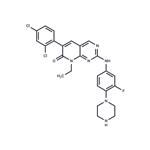FRAX486 is an inhibitor of group I p21-activated kinases (PAKs; IC50s = 8.25, 39.5, and 55.3 nM for PAK1, PAK2, and PAK3, respectively). It is selective for group I PAKs over PAK4, a group II PAK (IC50 = 779 nM). FRAX486 (20 mg/kg) reverses decreases in the mean density of apical dendritic spines in the temporal cortex in the Fmr1-/- mouse model of fragile X syndrome. It completely abolishes audiogenic seizures, hyperactivity, and stereotypical movements in Fmr1-/- mice when administered at a dose of 30 mg/kg. FRAX486 prevents adolescent cortical dendritic spine loss and rescues prepulse inhibition deficits in a Disc1 knockdown mouse model of schizophrenia.
FRAX 486 is a small-molecule PAK inhibitor. This compound has neuroprotective properties.
FRAX486 is a potent, group I-selective p21-activated kinase (PAK) inhibitor (PAK1/2/3 IC50 = 8.25/39.5/55.3 nM; group II PAK4 IC50 = 779 nM). FRAX486 effectively inhibits PAK-mediated PKD1 Ser203 phosphorylation and PAK1/2 Ser144/141 autophosphorylation upon angiotensin II (ANGII) stimulation of rat IEC-18 cells (IC50 ~0.5 μM) and exhibits in vivo efficacy in rescuing the autism-like phenotypes among Fmr1 knockout fragile syndrome (FXS) mice (20 mg/kg s.c.) as well as in ameliorating schizophrenia-associated dendritic spine deterioration among Disc1 knockdown mice (10 μg/g or 10 mg/kg i.p.) with good pharmacokinetic properties and blood–brain barrier (BBB) permeability.
previous study showed in wpmy-1 cells, frax486 could dose-dependently induce the degeneration of actin filaments, which was accompanied by proliferation rate attenuation. moreover, the frax486 cytotoxicity in wpmy-1 cells was found to be both time- and concentration-dependent. in addition, the effects of frax486 on actin organization, survival, and proliferation were observed at 1-5 μm in wpmy-1 cells, and complete inhibition of pak1-3 might be expected, whereas pak4 might be inhibited only partially at these concentrations [1].
animal study found that frax486 was able to cross the blood-brain barrier (bbb) and the brain therapeutical frax486 concentrations were detected as early as 1 h and remained as long as 24 h, with the maximum concentration (cmax) at 8 h. moreover, frax486 could reduce hyperactivity and stereotypical movements, both of which were phenotypes characterizing the fragile x syndrome mouse model [2].
14, 33, 39 and 575 nm for pak1, pak2, pak3 and pak4 respectively
[1] wang y,et al. p21-activated kinase inhibitors frax486 and ipa3: inhibition of prostate stromal cell growth and effects on smooth muscle contraction in the human prostate. plos one. 2016 apr 12;11(4):e0153312.
[2] dolan bm,duron sg,campbell da,vollrath b,shankaranarayana rao bs,ko hy,lin gg,govindarajan a,choi sy,tonegawa s. rescue of fragile x syndrome phenotypes in fmr1 ko mice by the small-molecule pak inhibitor frax486. proc natl acad sci u s a. 2013 apr 2;110(14):5671-6.
![Pyrido[2,3-d]pyriMidin-7(8H)-one, 6-(2,4-dichlorophenyl)-8-ethyl-2-[[3-fluoro-4-(1-piperazinyl)phenyl]aMino]- Structure](/CAS/20150408/GIF/1232030-35-1.gif)
